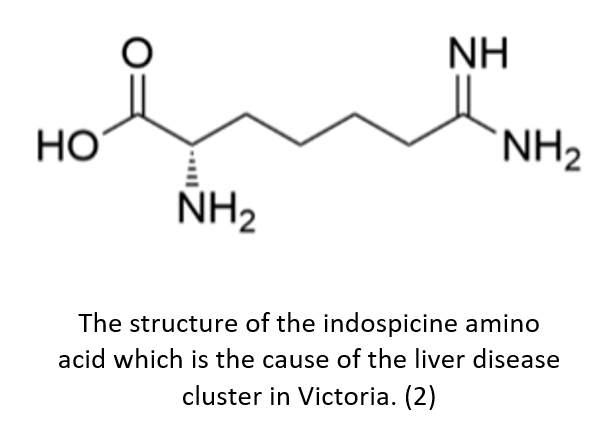Indoscipine poisoning in dogs
Indoscipine poisoning in Dogs
Meg Hamill
Bachelor of Biomedical Science student
Deakin University
There is currently a cluster of 40 dogs throughout the Traralgon, Bairnsdale, Mornington Peninsula and eastern suburbs of Melbourne who are suffering or have recently recovered from severe liver disease. An extra 21 have unfortunately already died from the disease. (1) A link between all cases has been drawn to the consumption of a specific raw pet meat product produced by the Maffra District Knackery in Gippsland. But what is it about this specific product that has created such consequences for dozens of dogs?
The toxin that has been found to have caused the deaths and hospitalisations of the 61 dogs is the indospicine toxin, which is found in certain species of plants of the genus Indigofera. Indigofera plants are located in every Australian state and are often a food source for grazing animals such as cattle, horses and camels. (2) The indospicine toxin, however, is only found in certain species, predominately Indigofera spicata and Indigofera linnaei. These species differ in preferred habitats, I. spicata thriving in the tropical and subtropical regions of the northern regions of Australia and I. linnaei in the dry, arid central and northern regions. What they both have in common is that neither of them can be seen in Victoria (3).


The indospicine toxin itself is unusual as it does not exist as part of a protein, but rather as a free amino acid (building blocks of proteins). The mammalian digestive system has a difficult time digesting indospicine and because of this it accumulates in its body tissue, especially in the pancreas and liver in camels, and in the muscle of horses. (5, 6) For the animals that graze on the indospicine containing plants, the accumulation of the toxin may lead to reduced animal performance, reduced weight gain as well as mild to severe liver disease. (2) The toxin however exhibits more dangerous effects in dogs who inadvertently consume animal meat that contains an accumulation of indospicine. In dogs, indospicine can cause a range of effects such as lethargy, diarrhoea, lack of appetite, jaundice, and an increase in thirst and frequent urination. (7) All of these are symptomatic of liver disease and all are being experienced by a cluster of dogs in the south east of Melbourne.
So how is a toxin only found in the northern regions of Australia creating such consequences for dogs in Victoria?
When the Maffra District Knackery acquired horses to use for their raw pet meat from northern Victoria, they were unaware that those horses were originally from the Northern Territory and had therefore accumulated the toxin. This unfortunately led to the exposure of indospicine to dozens of dogs in the Gippsland area, resulting in severe liver disease and the death of some.
Pet owners are now questioning the standard of pet food regulation in Victoria to understand how something like this has been allowed to happen. In Australia, pet food is self-regulated with the industry standards provided by the Pet Food Industry Association of Australia (PFIAA), however it is voluntary for pet food suppliers to join. (8) This means anyone not apart of PFIAA has no regulations they need to uphold. PFIAA executive manager Carolyn Macgill has spoken out saying that although the indospicine toxin was well known in the industry and is on their list of banned toxins, there is currently no regulator or enforcement from a government authority, meaning the standards cannot be mandated. (9)
References
1. Agriculture Victoria (Internet), Primesafe and Agriculture Victoria statement indospicine in pet meat - warning to dog owners; 2021 Hyk 30(cited 2021 Aug 12)https://agriculture.vic.gov.au/about/media-centre/media-releases/primesafe-and-agriculture-victoria-statement-indoscpicine-in-pet-meat-warning-to-dog-owners
2. Gilbert R A, Netzel G, Chandra K, Ouwerkerk D, Fletcher M T. Degredation of the Indospicine Toxin from Indigofera spicata by a Mixed Population of Rumen Bacteria. Toxins [Internet]. 2021 May 28 [cited 2021 Aug 16];13(6):18 p. Available from doi: 10.3390/toxins13060389
3.Netzel G, Palmar D G, Masters A M, Tai S Y, Allen J G, Fletcher M T. Assessing the risk of residues of the toxin indospicine in bovine muscle and liver from north-west Australia. Toxicon [Internet]. 2019 May 14 [cited 2021 Aug 16]; 163: 48-58. Available from doi: 10.1016/j.toxicon.2019.03.007
4. Mark Marathon (Own work) [CC BY-SA 3.0 (http://creativecommons.org/lisenses/by-sa/3.0)], via Wikimedia Commons
5. Netzel G, Tan E T T, Yin M, Giles C, Yong K W L, Jassim R A, Fletcher M T. Bioaccumulation and Distribution of Indospicine and Its Foregut Metabolites in Camels Fed Indigofera spicata. Toxins [Internet]. 2019 March [cited 2021 Aug 24]; 11(3):169. Available from doi: 10.3390/toxins11030169
6. Lima E F, Riet-Correa F, Gardner D R, Barros S S, Medeiros R M T, Soares M P, Reit-Correa G. Poisoning by Indigofera lespedezioides in horses. Toxicon [Internet]. 2012 Sept 1 [cited 2021 Aug 24]; 60(3): 324-328. Available from: https://doi.org/10.1016/j.toxicon.2012.04.341
7. FitzGerald L M, Fletcher M T, Paul A E H, Mansfield C S, O’Hara A J. Hepaptotoxicosis in dogs consuming a diet of camel meat contaminated with indospicine. Aust Vet J [Internet]. 2011 Mar [cited 2021 Aug 16]; 89: 95-100. Available from doi: 10.1111/j.1751-0813.2010.00684.x
8. RSPCA Knowledgebase [Internet]. Australia: RSPCA; c2021. How is the pet food industry regulated in Australia? 2019 Aug 12 [cited 2021 Aug 24]; [about 2 screens]. Available from: https://kb.rspca.org.au/knowledge-base/how-is-the-pet-food-industry-regulated-in-australia/
9. Field E. Victorian knackery expands meat recall as toxic-plant pet deaths probe continues. ABC News. [Internet] 2021 Jul 23 [cited 2021 Aug 24]; ABC Gippsland: [about 4 screens] Available from: https://www.abc.net.au/news/2021-07-23/knackery-recalls-horsemeat/100316496
Contact Details
Secretary: L Brodie Liaison Officer: A FullerMelbourne, VIC, Australia
Email : [email protected]
